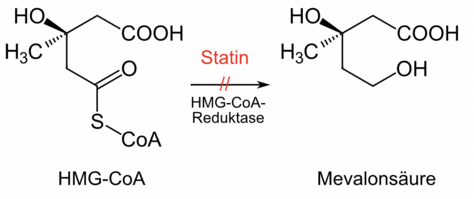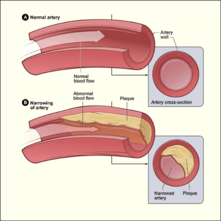Statins: Difference between revisions
No edit summary |
No edit summary |
||
| Line 6: | Line 6: | ||
== Introduction == | == Introduction == | ||
[[File:Statin.png|thumb|474x474px|Schematic mechanism of action of statins]] | [[File:Statin.png|thumb|474x474px|Schematic mechanism of action of statins]] | ||
Statin medications | Statin medications are a class of [[Lipids|lipid]]-lowering medications that decrease illness and mortality in those who are at high risk of [[Cardiovascular Disease|cardiovascular disease]], being the most common cholesterol-lowering drugs<ref>Sizar O, Khare S, Jamil RT, Talati R. [https://www.ncbi.nlm.nih.gov/books/NBK430940/ Statin medications.] InStatPearls [Internet] 2021 Jan 3. StatPearls Publishing. Available: https://www.ncbi.nlm.nih.gov/books/NBK430940/<nowiki/>(accessed 9.4.2022)</ref>. | ||
# Statins are designed to lower low-density lipoprotein (LDL) cholesterol in the [[blood]]. They do this by lowering the amount of cholesterol plaque that forms in the arteries. | # Statins are designed to lower low-density lipoprotein (LDL) cholesterol in the [[blood]]. They do this by lowering the amount of cholesterol plaque that forms in the arteries. | ||
| Line 30: | Line 30: | ||
# The incidence of myopathy is dose-dependent and may present as diffuse myalgias or otherwise unexplainable muscle tenderness or weakness that may reverse upon medication discontinuation. | # The incidence of myopathy is dose-dependent and may present as diffuse myalgias or otherwise unexplainable muscle tenderness or weakness that may reverse upon medication discontinuation. | ||
# Rhabdomyolysis is the most serious complication of statin use, but its occurrence is rare. | # Rhabdomyolysis is the most serious complication of statin use, but its occurrence is rare. | ||
# Statin-associated immune-mediated necrotizing [[Inflammatory Myopathies|myopathy]](IMNM) can occur due to the development of [[Immunoglobulins (Ig)|antibodies]] against the HMG-CoA reductase [[Enzymes|enzyme]]. Symmetrical, proximal muscle weakness with significantly increased creatine phosphokinase (CPK) that continues for months after ceasing statins is common in IMNM<ref>Sizar O, Khare S, Jamil RT, Talati R. [https://www.ncbi.nlm.nih.gov/books/NBK430940/ Statin medications.]Available:https://www.ncbi.nlm.nih.gov/books/NBK430940/ (accessed 4.2.2024)</ref> | |||
Avoid mixing statins with grapefruit. Grapefruit causes an increase to the side effect of the drugs. This could put you at risk for muscle breakdown, [[Liver Disease|liver damage]], and [[Chronic Kidney Disease|kidney failure]]. More mild cases can cause pain in the joints and muscles. | Avoid mixing statins with grapefruit. Grapefruit causes an increase to the side effect of the drugs. This could put you at risk for muscle breakdown, [[Liver Disease|liver damage]], and [[Chronic Kidney Disease|kidney failure]]. More mild cases can cause pain in the joints and muscles. | ||
Revision as of 08:03, 4 February 2024
Original Editor - Lucinda hampton
Top Contributors - Lucinda hampton and Mason Trauger
Introduction[edit | edit source]
Statin medications are a class of lipid-lowering medications that decrease illness and mortality in those who are at high risk of cardiovascular disease, being the most common cholesterol-lowering drugs[1].
- Statins are designed to lower low-density lipoprotein (LDL) cholesterol in the blood. They do this by lowering the amount of cholesterol plaque that forms in the arteries.
- Statins may also inhibit many of the structural and functional components of the arteriosclerotic process. Structural effects include reductions in vascular smooth muscle hypertrophy and proliferation, fibrin deposition, and collagen cross-linking. Among the functional effects are improvements in endothelial function, reduction in inflammatory cytokines and reactive oxygen species, and down-regulation of angiotensin II and endothelin receptors.[2]
There are several different types of statins. The main difference between them is their potency.
Uses[edit | edit source]
Clinicians use statin medications for the treatment of
- Hypercholesterolemia,
- Hyperlipoproteinemia
- Hypertriglyceridemia
- Atherosclerosis
- Myocardial infarction prophylaxis
- Stroke prophylaxis
Adverse Effects[edit | edit source]
Statins are usually well-tolerated, with myositis, rhabdomyolysis, hepatotoxicity, and diabetes mellitus being the most common adverse reactions.
- The incidence of myopathy is dose-dependent and may present as diffuse myalgias or otherwise unexplainable muscle tenderness or weakness that may reverse upon medication discontinuation.
- Rhabdomyolysis is the most serious complication of statin use, but its occurrence is rare.
- Statin-associated immune-mediated necrotizing myopathy(IMNM) can occur due to the development of antibodies against the HMG-CoA reductase enzyme. Symmetrical, proximal muscle weakness with significantly increased creatine phosphokinase (CPK) that continues for months after ceasing statins is common in IMNM[3]
Avoid mixing statins with grapefruit. Grapefruit causes an increase to the side effect of the drugs. This could put you at risk for muscle breakdown, liver damage, and kidney failure. More mild cases can cause pain in the joints and muscles.
Smoking cigarettes should also be avoided when taking statins. Smoking decreases the positive effects of statins. Smokers had a 74 to 86 % higher risk of events[4].
Physiotherapy Implications[edit | edit source]
Statins may increase the incidence of exercise-related muscle complaints and in some studies augment the exercise-induced rise in muscle enzymes, but statins do not consistently reduce muscle strength, endurance, overall exercise performance or physical activity.[5]
References[edit | edit source]
- ↑ Sizar O, Khare S, Jamil RT, Talati R. Statin medications. InStatPearls [Internet] 2021 Jan 3. StatPearls Publishing. Available: https://www.ncbi.nlm.nih.gov/books/NBK430940/(accessed 9.4.2022)
- ↑ Mangat S, Agarwal S, Rosendorff C. Do statins lower blood pressure?. Journal of cardiovascular pharmacology and therapeutics. 2007 Jun;12(2):112-23.Available: https://journals.sagepub.com/doi/abs/10.1177/1074248407300380(accessed 9.4.2022)
- ↑ Sizar O, Khare S, Jamil RT, Talati R. Statin medications.Available:https://www.ncbi.nlm.nih.gov/books/NBK430940/ (accessed 4.2.2024)
- ↑ Healthline Will Statins Lower My Blood Pressure? Available: https://www.healthline.com/health/statins-will-they-lower-my-blood-pressure (accessed 9.4.2022)
- ↑ Noyes AM, Thompson PD. The effects of statins on exercise and physical activity. Journal of clinical lipidology. 2017 Sep 1;11(5):1134-44. Available: https://pubmed.ncbi.nlm.nih.gov/28807461/(accessed 9.4.2022)









